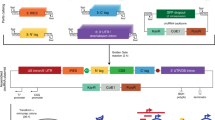Abstract
In nuclear transgenic plants, expression of multiple genes requires introduction of individual genes and time-consuming subsequent backcrosses to reconstitute multi-subunit proteins or pathways, a problem that is compounded by variable expression levels. In order to accomplish expression of multiple genes in a single transformation event, we have introduced several genes into the chromoplast genome. We confirmed stable integration of the cry2Aa2 operon by PCR and Southern blot analyses in T0 and T1 transgenic plants. Foreign protein accumulated at 45.3% of the total soluble protein in mature leaves and remained stable even in old bleached leaves (46.1%), thereby increasing the efficacy and safety of transgenic plants throughout the growing season. This represents the highest level of foreign gene expression reported in transgenic plants to date. Insects that are normally difficult to control (10-day old cotton bollworm, beet armyworm) were killed 100% after consuming transgenic leaves. Electron micrographs showed the presence of the insecticidal protein folded into cuboidal crystals. Formation of crystals of foreign proteins (due to hyperexpression and folding by the putative chaperonin, ORF 2) provides a simple method of purification by centrifugation and enhances stability by protection from cellular proteases. Demonstration of expression of an operon in transgenic plants paves the way to engineering new pathways in plants in a single transformation event.
This is a preview of subscription content, access via your institution
Access options
Subscribe to this journal
Receive 12 print issues and online access
$209.00 per year
only $17.42 per issue
Buy this article
- Purchase on Springer Link
- Instant access to full article PDF
Prices may be subject to local taxes which are calculated during checkout






Similar content being viewed by others
References
Bogorad, L. Engineering chloroplasts: an alternative site for foreign genes, proteins, reactions, and products. Trends Biotechnol. 18, 257–263 (2000).
Navrath, C., Poirier, Y. & Somerville, C. Targeting of the polyhydroxybutyrate biosynthetic pathway to the plastids of Arabidopsis thaliana results in highlevels of polymer accumulation. Proc. Natl. Acad. Sci. USA 91, 12760–12764 (1994).
Ma, J. et al. Generation and assembly of secretory antibodies in plants. Science 268, 716–719 (1995).
Ye, X. et al. Engineering the provitamin A (β-carotene) biosynthetic pathway into (carotenoid-free) rice endosperm. Science 287, 303–305 (2000).
Daniell, H. New tools for chloroplast genetic engineering. Nat. Biotechnol. 17, 855–856 (1999).
Daniell, H. GM crops: public perception and scientific solutions. Trends Plant Sci. 4, 467–469 (1999).
Crickmore, N. & Ellar, D. Involvement of a possible chaperonin in the efficient expression of a cloned cryIIA δ-endotoxin gene in Bacillus thuringiensis. Mol. Microbiol. 6, 1533–1537 (1992).
Ge, B. et al. Differential effects of helper proteins encoded by the cry2A and cry11A operons on the formation of Cry2A inclusions in Bacillus thuringiensis. FEMS Microbiol. Lett. 165, 35–41 (1998).
Crickmore, N., Wheeler, V. & Ellar, D. Use of an operon fusion to induce expression and crystallisation of a Bacillus thuringiensis δ-endotoxin encoded by a cryptic gene. Mol. Gen. Genet. 242, 365–368 (1994).
Greenplate, J. Quantification of Bacillus thuringiensis insect control protein Cry1Ac over time in bollgard cotton fruit and terminals. J. Econ. Entomol. 92, 1377–1383 (1999).
Daniell, H., Datta, R., Gray, S., Varma, S. & Lee, S. Containment of a herbicide resistance through genetic engineering of the chloroplast genome. Nat. Biotechnol. 16, 345–348 (1998).
Guda, C., Lee, S.B. & Daniell, H. Stable expression of a biodegradable protein-based polymer in tobacco chloroplasts. Plant Cell Rep. 19, 257–262 (2000).
Daniell, H. Foreign gene expression in chloroplasts of higher plants mediated by tungsten particle bombardment. Methods Enzymol. 217, 536–556 (1993).
Daniell, H. Transformation and foreign gene expression in plants mediated by microprojectile bombardment. Methods Mol. Biol. 62, 463–489 (1997).
Kota, M. et al. Overexpression of the Bacillus thuringiensis (Bt) Cry2Aa2 protein in chloroplasts confers resistance to plants against susceptible and Bt-resistant insects. Proc. Natl. Acad. Sci. USA 96, 1840–1845 (1999).
Yamamoto, T. & Iizuka, T. Two types of entomocidal toxins in the parasporal crystals of Bacillus thuringiensis var. kurstaki. Arch. Biochem. Biophys. 227, 233–241 (1983).
Bradley, D., Harkey, M., Kim, M., Biever, K., & Bauer, L. The insecticidal CryIB crystal protein of Bacillus thuringiensis ssp. thuringiensis has dual specificity to coleopteran and lepidopteran larvae. J. Invert. Pathol. 65, 162–173 (1995).
Daniell, H., Dessai, P., Prakash, C. & Moar, W. Engineering plants for stress tolerance via organelle genomes. NATO ASI Series 86, 589–592 (1994).
Roy, H. & Nierzwicki-Bauer, S. RuBisCo: genes, structure, assembly and evolution. In The photosynthetic apparatus (eds Bogorad, L. & Vasil, I.) 347–364 (Academic Press, New York; 1994).
Moar, W., Trumble, J., Hice, R. & Backman, P. Insecticidal activity of the CryIIA protein from the NRD-12 isolate of Bacillus thuringiensis subsp. kurstaki expressed in Escherichia coli and Bacillus thuringiensis and in a leaf-colonizing strain of Bacillus cereus. Appl. Environ. Microbiol. 60, 896–902 (1994).
Moar, W. et al. Development of Bacillus thuringiensis Cry1C resistance by Spodoptera exigua. Appl. Environ. Microbiol. 61, 2086–2092 (1995).
Vrekleij, A.J & Leunissen, J.M., eds. Immuno-gold labeling in cell biology (CRC Press, Boca Raton, FL; 1989).
Acknowledgements
We thank F. Gould (North Carolina State University) for providing Heliothis virescens. This study was supported in part by the USDA-NRICGP grants 95-37500-2664, 97-35504-5297, and 98-35300-6973 to H.D.
Author information
Authors and Affiliations
Corresponding author
Rights and permissions
About this article
Cite this article
Cosa, B., Moar, W., Lee, SB. et al. Overexpression of the Bt cry2Aa2 operon in chloroplasts leads to formation of insecticidal crystals. Nat Biotechnol 19, 71–74 (2001). https://doi.org/10.1038/83559
Received:
Accepted:
Issue Date:
DOI: https://doi.org/10.1038/83559
This article is cited by
-
Engineering of insecticidal hybrid gene into potato chloroplast genome exhibits promising control of Colorado potato beetle, Leptinotarsa decemlineata (Coleoptera: Chrysomelidae)
Transgenic Research (2023)
-
Chloroplast Engineering: Fundamental Insights and Its Application in Amelioration of Environmental Stress
Applied Biochemistry and Biotechnology (2023)
-
The production of the first functional antibody mimetic in higher plants: the chloroplast makes the DARPin G3 for HER2 imaging in oncology
Biological Research (2022)
-
Replicating minichromosomes as a new tool for plastid genome engineering
Nature Plants (2021)



